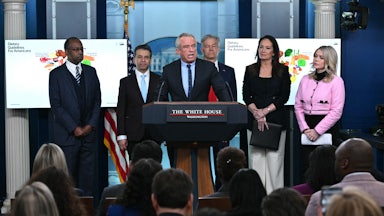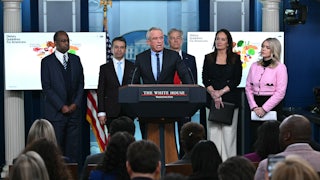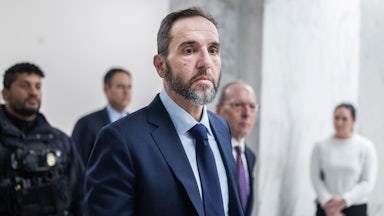The year is 1998. While antiviral drugs to treat HIV had been approved a decade earlier, only five out of 33 million people who carried the virus were receiving the lifesaving treatment. Nowhere was the situation worse than in South Africa. The country had the highest global prevalence of the disease with nearly one in five people infected and 200,000 children orphaned.
Treatment options were limited. That year, the minister of health released a report outlining the deficiencies in the country’s health care system. The principal finding was that most South Africans could not afford antivirals. The average monthly income at the time hovered around $220 a month, which was nowhere near the $1,000 per month the pharma companies were charging for their wares. Faced with a virus that was decimating his population, Nelson Mandela made a choice that landed him in court for the first time since his arrest several decades earlier for resisting apartheid.
His government broke the patent regime for the antivirals that was chiefly responsible for killing his people—allowing parallel imports in which generics companies manufacture the drug without the patent-holding pharma company’s consent. He was instantly sued by 40 pharmaceutical companies. Bill Clinton’s administration cowered to pressure from the pharma lobby and placed South Africa on a watch list, subjecting the nation to possible trade sanctions. It ended up being an enormous P.R. disaster for the obstreperous pharmaceutical firms. After three years of mounting pressure from AIDS activists, the pharma companies finally dropped their case.
While this story has a happy ending, Mandela’s battle against Big Pharma was only a small part of an ongoing war to provide equitable access to HIV medication. In the decades since his court case, taxpayer-funded research has contributed enormously to the development of new HIV treatments. New drugs can now allow people living with HIV to enjoy normal lifespans, and completely reduce the risk of new transmissions. Used widely, medications should allow the complete eradication of HIV from the planet. The only obstacle the world is now facing is the same one Mandela stared down: corporate greed which prioritizes profits over human life.
In 2012, the U.S. Food and Drug Administration approved Truvada for the use of pre-exposure prophylaxis, or PrEP, which reduces the risk of HIV transmission. Recent research revealed that U.S. taxpayers contributed over $143 million to clinical testing and development of Truvada. But despite the role public institutions played in bringing the medication to market, the profits have gone to the pharmaceutical company Gilead, which owns and markets the drug.
By 2019, the pharma company had made $36 billion in profits from Truvada thanks in part to pricing that followed no logical line of reasoning. When it was first approved as a treatment for HIV in 2004, Gilead charged $7,800 per year for treatment. By 2019 the cost had ballooned to $20,000 per year. Similar drug combinations to Truvada were available in other countries for as little as $60 per year.
To combat bad P.R., Gilead promised to donate 2.4 million vials of PrEP each year for 11 years to 200,000 uninsured individuals at risk of contracting HIV. While this is a nice gesture, the Centers for Disease Control and Prevention reported that there were 1.1 million Americans “at substantial risk for HIV” who “should be offered PrEP.”
Testifying before the U.S. House Committee on Oversight and Accountability, Tim Horn, director of medication access and pricing at the National Alliance of State & Territorial AIDS Directors, or Nastad, accused the pharma giant of using donation tactics to mask the impact high prices were having on access for the uninsured. “To be clear, these programs are not a substitute for functioning public health and healthcare systems,” he said. “Partnerships with pharmaceutical manufacturers will always be important, but outsized dependency on their generosity—which, in turn, is dependent on their bottom line—is by no means a solution.”
Gilead’s practice of charging sky-high prices for treatment has not been the only barrier to access. This year, the pharma company paid $40 million to patients who developed kidney and bone diseases from taking Truvada after allegations that the company withheld the release of a safer drug so that it could extend profits until the patents expired. This practice, known as “product hopping,” is not uncommon in the pharmaceutical industry. Just before one medical product’s patents are set to expire, the pharma company will release an upgraded version to prolong its monopoly.
Another common tactic pharma companies use to maximize profits is a practice known as “pay for delay.” Just before a medication is set to go off-patent, the pharma company will pay a generic manufacturer not to produce the drug. In 2019, plaintiffs sued Gilead for allegedly paying Teva, a generic drug manufacturer, $1.5 billion in exchange for staying out of the Truvada market for five years. Gilead won the case in 2023, thanks in no small part to a 2013 U.S. Supreme Court ruling that made it easier for pharma companies to design pay-for-delay deals that would stand up in court.
Recently, Gilead has developed a new form of PrEP called Lenacapavir. Unlike many other forms of PrEP that come in pill form, Lenacapavir is an injection administered twice a year. In trials, the injection was found 100 percent effective at HIV prevention and superior to daily-administered Truvada.
The good news is that Gilead has announced that it has signed licensing agreements with generic manufacturers to provide the injections to 120 low- and middle-income countries. The bad news is that for everyone else, the price tag is $42,000 per year. The Lancet reported that Australia was at a “distressing impasse” over the cost of injectables. And although countries in Eastern Europe, North Africa, and Latin America are still experiencing increasing numbers of HIV infections, many of them were left out of Gilead’s licensing agreement. Brazil is one such example, despite the fact it hosted clinical trials for PURPOSE 2 trials of Lenacapavir. To add insult to injury, recent research from Liverpool University in the U.K. revealed the injectable could be produced for as little as $40 per year.
The pharma industry has historically been very good at formulating arguments that justify its greed. The first is that pricing reflects the high costs of the research and development it takes to bring new drugs to market. In fairness, when the cost of all the failed drug trials is included, the mean cost of development for a new drug can reach $870 million.
However, there are a few problems with Big Pharma’s argument. The first is that most early-stage research when clinical trials are the most likely to fail is funded by taxpayer money. In fact, the National Institutes for Health is the world’s largest public funder of medical research. The second problem is that the pharma industry spends millions a year lobbying Congress to keep its research and development costs a secret. It’s one thing to tell Congress you need to charge high prices to recover your costs, but it’s a little disingenuous if you spend $379 million a year to make sure nobody knows what those costs are.
There are solutions that the government can use to make sure that taxpayer-funded medicines remain accessible to everyone. One would be if the U.S. government exercised what is known as “march-in rights” to guarantee that all drugs that receive FDA approval and were funded in part with taxpayer money are sold at fair and reasonable prices. Charities that conduct critical medical research could also stipulate that any pharma companies that license their research must provide the outcomes of that research at fair prices.
Since the first cases of HIV were identified in 1981, 42 million people have gone on to die from the virus. Unknown millions have died preventable deaths because the medicine they needed to survive was priced out of their reach. Millions more have become infected for the same reason.
The decision to leave the responsibility of developing lifesaving HIV drugs with pharma companies was a political and societal choice—and an errant one at that. HIV will not be the last virus to claim millions of lives. Just recently, the world saw how unequal access to Covid-19 vaccines resulted in millions of preventable deaths, there is growing concern about the threat posed by the H5N1 strain of avian flu, and climate change–induced viruses are likely to emerge in the future to claim even more lives. The HIV crisis provided a powerful lesson of what happens when the law prioritizes corporate profits over human life. It’s up to us whether we decide to repeat the same mistake.










